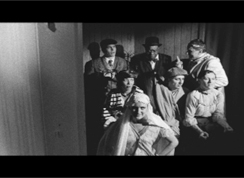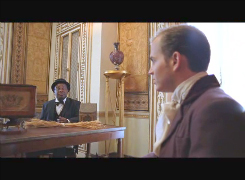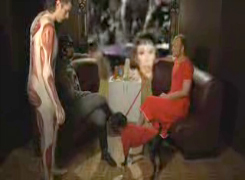Get the Flash Player to see this player.
Excerpt of Chicago footage from Catherine Sullivan’s multichannel installation Triangle of Need, 2007. Courtesy the artist, Galerie Catherine Bastide, and Metro Pictures.
Get the Flash Player to see this player.
Excerpt of Vizcaya footage from Catherine Sullivan’s multichannel installation Triangle of Need, 2007. Courtesy the artist, Galerie Catherine Bastide, and Metro Pictures.
Get the Flash Player to see this player.
Excerpt from ARTV 24103’s single-channel video Untitled, 2008. Courtesy the artists.

Excerpt of Chicago footage from Catherine Sullivan’s multichannel installation Triangle of Need, 2007. Courtesy the artist, Galerie Catherine Bastide, and Metro Pictures.

Excerpt from Vizcaya footage of Catherine Sullivan’s multichannel installation Triangle of Need, 2007. Courtesy the artist, Galerie Catherine Bastide, and Metro Pictures.

Excerpt from ARTV 24103’s single-channel video Untitled, 2008. Courtesy the artists.
Interview: Catherine Sullivan and Stephanie Smith
SS: How does Triangle of Need fit into the larger context of your work?
CS: It’s the most extensively collaborative work I have made, and like much of what I have done since 2000, it has an overt political motivation.
SS: What initially drew you to the genre of the scam e-mail as source material? How did you choose this particular narrative? What did you find compelling about the prospect of creating a work around the characters of Dr. Obi, Harold Bowen, and Next of Kin?
CS: I was commissioned to make a project in Miami at Vizcaya Museum and Gardens, which is the former home of industrialist James Deering. Built in 1916, the home was conceived as an expansive series of architectural and decorative vignettes, manifesting 400 years of pan-European stylistic chronology. I had the feeling when I visited there the first time that I was witness to a primal scene in the evolution of concentrated wealth in America. The subtropical climate makes preservation difficult, and it’s as if you can smell the decomposition of the American Renaissance, the irony of what had once been emblematic of a national self-confidence, now turned into a municipal museum, and like all things municipal, confronted with endless financial deficits.
At the same time I was receiving a lot of scam e-mails from Nigeria. These advance fee fraud scams cleverly confuse empathy and greed. Someone very wealthy has died tragically, there are no heirs, and a loose associate of the deceased needs to present you as the Next of Kin in order to collect the money. You will be richly rewarded for helping someone. Authored by members of a third world society and addressed to members of a first world society, these e-mails subjectivize a recipient who is greedy and at the same time regards himself as a “good person,” as superior, this is exactly the point at which he becomes vulnerable.
My encounter with the facades of Vizcaya and the e-mail were convergent, and I started to work with the notion that Vizcaya could be the spatialization of the e-mail; the mythic 20.5 million dollars could be evidenced, so could the greed, the economic disparities. The cult of superiority founded in the time of Deering could be projected back onto itself through Dr. Obi’s e-mail. The characters were there, but I was interested in the persona of Dr. Patrick Obi, because in the e-mails he is a name who shades another identity. In our piece, Dr. Patrick Obi doesn’t assume he knows why he is involved with the other characters, he is sort of recast over and over in these “vestigial” narratives.
SS: The e-mail is only one of the sources for the work. How did you settle on this particular constellation of sources?
CS: It was a combination of factors motivated by the regard I had for the [project] location. In this case I was drawn to the popular imagination of the time. I was working with a catalogue from Pathescope Films that James Deering would use to order films for screening at Vizcaya. I was trying to work with characters and fictional material from the catalogue and set it within Vizcaya, and in an apartment building also from the period in Chicago, the home of Dearing’s factory. A lot of it is about what happens to this imagination as it expands and contracts in these two settings defined by entirely opposing economic realities. The locus of production and expenditure are host to the action at the same time with different effects. If I was more Brechtian I would say “consequences,” but I can’t claim to have a clear sense of this.
I have been working with composer Sean Griffin for over ten years. Sean always brings additional interests to the work, and when I started talking to him about this project, it was clear that there was finally a mise-en-scène for a language he was developing based on recent discoveries about Neanderthal speech. Like much of the work I have made in the Bush era, there is an aspect of the content which is really about this last dance we’re having on the Titanic, and it made perfect sense to us that the Neanderthals should also be on board. The inclusion of this reference has been most puzzling to people, and I can’t tell if it’s because it is so obvious or so obscure. I was interested in the scientific metaphor of the Neanderthal—there is something inherently aggressive about Cro-Magnon man, and the encounter with the Neanderthal led to their extinction. It was one of the first genocides. This overlapped with Sean’s interest in science as a cultural act, most notably obvious in the colonial period (the period of Vizcaya) which reinforced disturbing assumptions about the primitive. It’s still debatable what a Neanderthal was and what happened to them; for Sean they become the basis to look at the cultural presumption of superiority, and for me this is not unrelated to the psychic economy which drives Vizcaya.
SS: What elements of the original e-mail narrative do you think are most crucial to the final work?
CS: I think it’s not so much the elements of the narrative which are crucial, but more what the e-mail is symptomatic of, and what it suggested I allow myself to look at. This e-mail could not be used to bring anything into focus, it can’t clearly articulate anything, it’s a tool, a device with very blunt motives, and so I was more interested in the content which could be agitated through it. Because I was working with this e-mail, I think what is most important to the final work is that I invited a director named Kunle Afolayan to direct some scenes, as a matter of opening up some of the more difficult and painful questions of the economic divide between myself and Dr. Patrick Obi. I knew there was a huge video-film culture in Nigeria, and I eventually decided to work with Kunle because of a melodrama he directed called Arapada. Kunle’s films like [those of ] many of his colleagues in Nigeria are emphatic about genre, emphatic about character, plot, action— things absolutely familiar to me in terms of their naturalism, but the criteria for what that naturalism delivers was absolutely foreign. That’s a strange feeling. I thought it would be interesting to work with someone whose aesthetic politic would require me to confront narrative issues which had not yet been important to me. It was a very demanding experience, and in the end I don’t think Kunle ever got the script he wanted and so he directed a ten-minute adaptation with some of my scenes, and then I used some of his scenes in my version. Interestingly enough, a full collaboration doesn’t exist.
SS: I love the way that moments of spoken English, clearly residue of the formal-but-slightly-off syntax of the original e-mail, punctuate a few moments of the piece. Why did you retain those bits of English amidst the Neanderthal?
CS: Sean developed the Neanderthal language, Mousterian, but also developed it as a dialect which could be applied to the e-mail, the only text you hear in English. It was really a way for the Harold Bowen character to be able to remind you of his presence through these different mutations of the text from the e-mail.
SS: Do you see a role for humor and/or the absurd in your work? The idea of creating a backstory for a Nigerian scam e-mail is pretty hilarious on one level, as is the idea of speaking Neanderthal. But both notions are also laden with critical and metaphoric potential that move into quite dark territory around current social relations and basic aspects of the human condition.
CS: Sean Griffin often says “I trust laughter,” and so I think when we encounter something in the work which makes us laugh, it feels strange to repress it. Maybe it signifies the distance between us and some of the traumas we refer to.
SS: Could you talk a bit about the various layers of collaboration involved in making this piece?
CS: All of the collaborators developed their material separately. We tried to have all of the elements together as much as possible, but in this case, the choreographer and two dancers were in Minneapolis, the composer and ensemble in Chicago, and the guest director in Nigeria. I usually work with people who have a strong creative will, and who I can depend on to be thorough. In this case, Kunle really knew what he wanted as far as a type of script, Sean and Dylan were really happy to work with the material historically and in terms of their own imaginations. We were all aware of the opportunities for dance, music, and cinema given the period we were referencing, and I think everyone really enjoyed that.
SS: By adapting source material, you put some parameters or constraints around your creative process: you simultaneously limit the field of possible actions and generate the possibility for something new. Does that seem accurate?
CS: I never really know what will happen to the sources when the piece is finished. I don’t feel as though I am performing a kind of treatment on them. The sources are always regarded as active regimes. They perform differently under different constraints or possibilities. They are an occasion to demonstrate regard for the culture, they have both a specific and an arbitrary function, they also have contingent histories and the best way for me to get at this is to open them up to new contingencies, new relationships.
SS: If so, do you see a relationship to the methodologies that you use with your performers in order to create their characters and movements?
CS: We are working out a number of things; every project requires the ensemble to confront different things.
SS: What was the most important thing that you learned through the process of working on Triangle of Need?
CS: To trust my symptoms. Because the work is often directed outward, I sometimes have forgotten that I am a cultural subject as well. In this project, I stumbled across symptoms of my own—in one scenario from the Pathescope catalogue, I misread the characters as gypsies. Due to Kunle’s presence, the institutional gauntlet of race, class, and gender was thrown down very early in the process of making this work and for a while I was very afraid of how to handle the emerging representations. It was when I accidentally ascribed an ethnicity to one of the characters that I realized that this was probably evident throughout the piece, and it simply had to be left alone; to “correct” any aspect of what had emerged from these sources being situated within one very imperfect apparatus would have been wrong.
SS: In conjunction with the exhibition, you taught a practicum course about the idea and practice of adaptation. Through the class, you and your University of Chicago students have formed a collective, ARTV 24103, and are collaborating on a new work that will be part of the exhibition’s Chicago presentation. Could you talk about the ideas that you’ve been exploring together and the process of creating the piece?
CS: It was really important to me that if the class was going to present something in the exhibition, that we produce it together. I was also interested not only in the sense in which adaptation had to do with the transience of media, but in what happens when you have a working ecology of elements and ideas which have to adapt to one another. I really tried to push the group to work with this idea, to work with contingencies. They could co-opt aspects of each other’s material and allow it to generate unanticipated meaning. Because we were making a video we had great opportunity for an ongoing recombination of elements, and so in he end you have adapted sources which adapt to one another. Also, I was a strong advocate that they work through a lot of content for the sake of seeing where it would go if taken to the extreme of adaptation. In the end I think there is the sense that all of the material is in some way connected.















